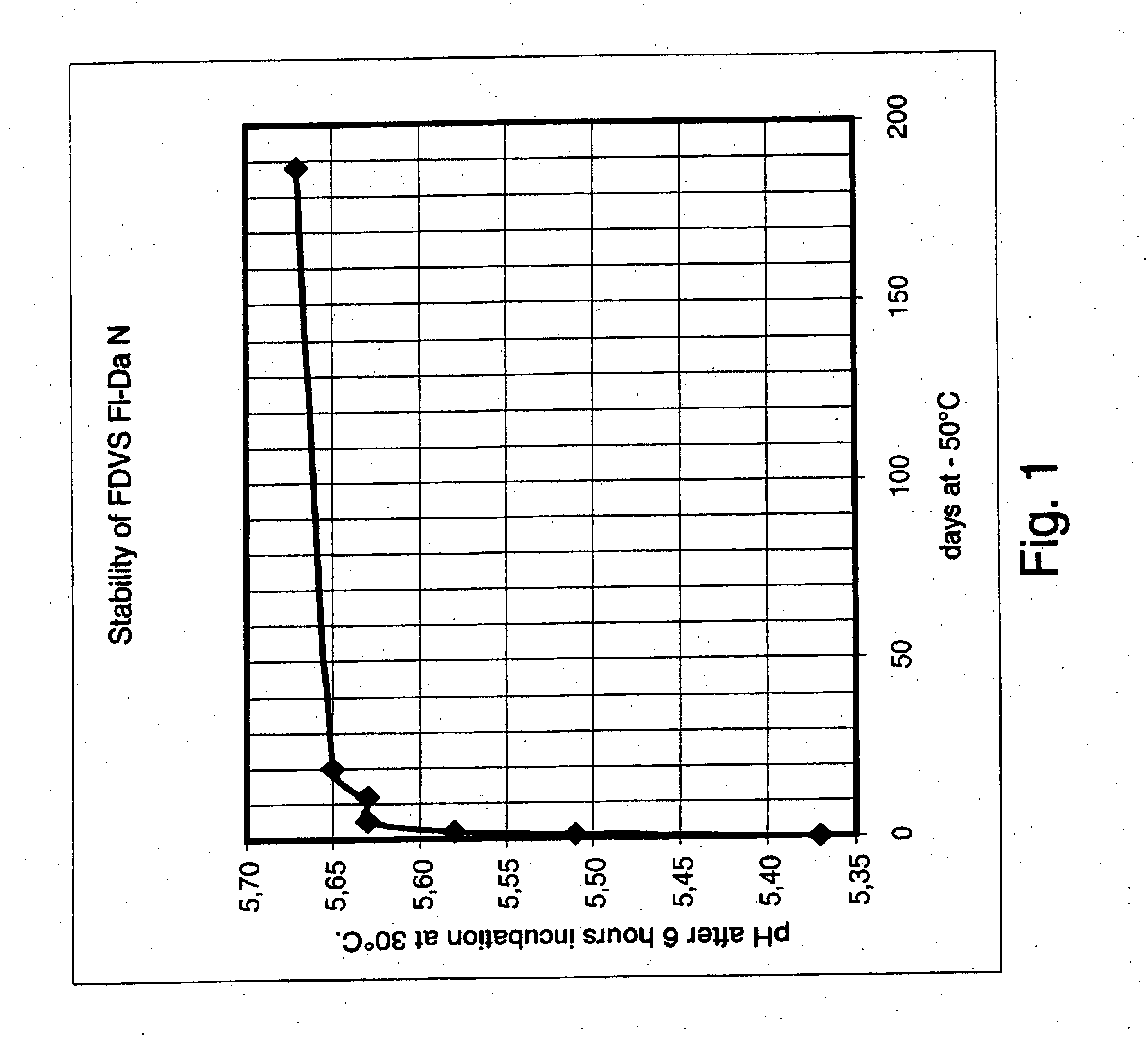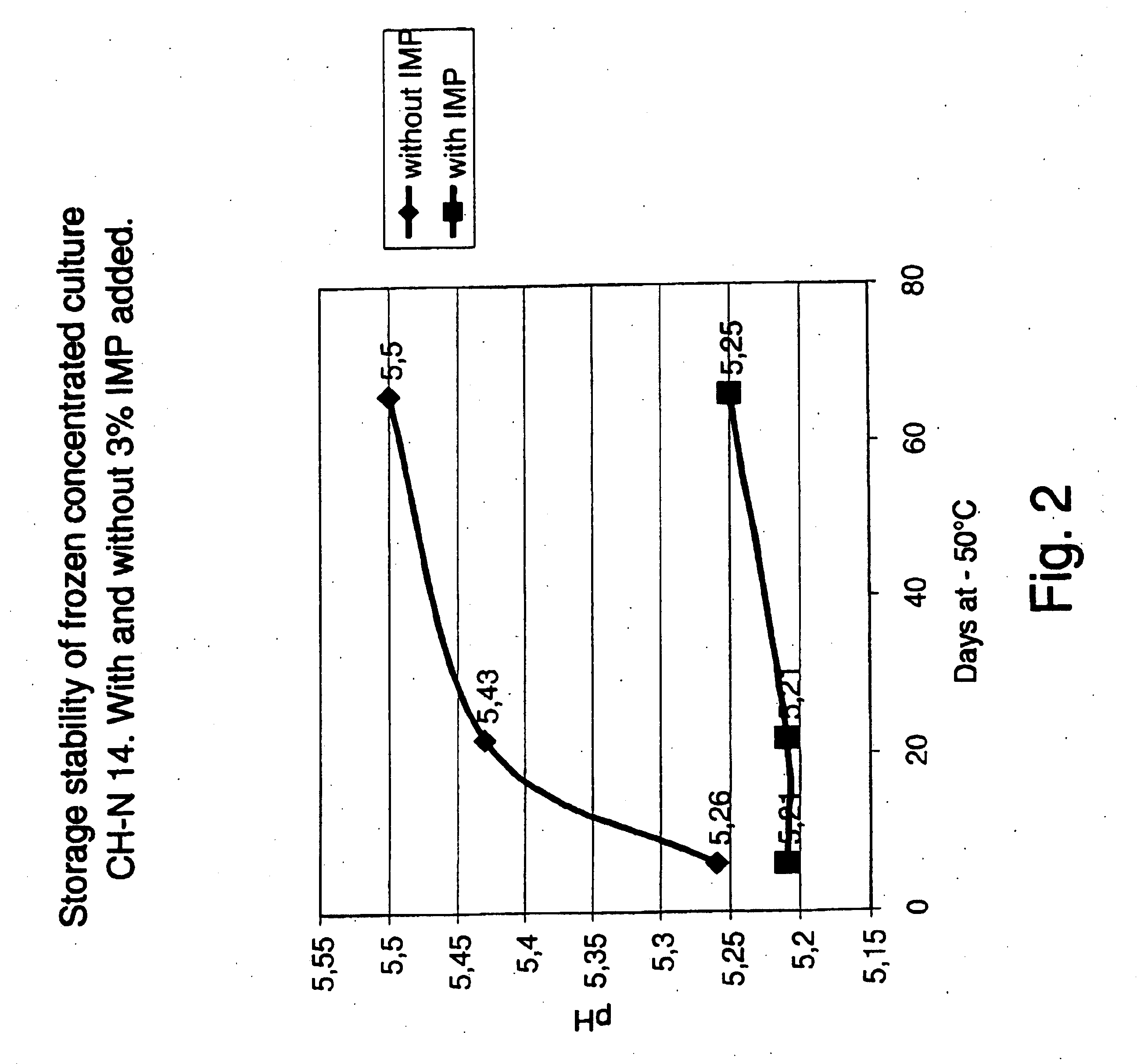Use of compounds involved in biosynthesis of nucleic acids as cryoprotective agents
a technology of biosynthesis and compounds, applied in the field of freezing and freezing microbial cultures and compounds involved in biosynthesis of nucleic acids as cryoprotective agents, can solve the problems of unrecognised stability problems, large amounts of cryoprotective agents, and general non-significant viability issues
- Summary
- Abstract
- Description
- Claims
- Application Information
AI Technical Summary
Benefits of technology
Problems solved by technology
Method used
Image
Examples
example 1
Stability study of frozen LD-culture of Fl-Da N
In this example the stability measured by the acidification activity of a commercially produced LD-culture: F-DVS™ Fl-Da N (Chr. Hansen A / S Item. No. 501691) was followed over a period of 6 months. The culture was produced and stored at −50° C. as described in the Materials and Methods section.
In contrast to what is common the first activity-measurement in this example was performed immediately after the culture were frozen as pellets in liquid nitrogen and followed by measurements after 1, 2, 12, 20 and 188 days of storage at −50° C.
The results of this experiment are shown in FIG. 1.
The acidification activity was drastically decreased during the very first few days of storage. After only one week of storage the acidification activity was reduced with 0.26 pH unit. This reduction is equivalent to a 50% reduction of the acidification activity after only one week of storage. After two weeks of storage further loss of the cultures ...
example 2
Stability Study of Frozen LD-Culture of CH N14 Using IMP as Cryoprotective Agent
This example describes the stability study with frozen direct vat set cultures (F-DVS™) of CH N14 formulated with IMP as cryoprotective agent. In the experiments the concentration of IMP was kept at 3% w / w per gram concentrated biomass. The IMP was added to the concentrate as a 30% w / w sterile solution.
After fermentation, biomass was harvested and concentrated via centrifugation from fermentation broth of F-DVS™ CH N 14. The cell concentrate was divided into two portions of 300 gram each and IMP was added to one of the portion. The additives and concentrates were mixed for 30 minutes, frozen in liquid nitrogen and subsequently stored at −50° C. The frozen culture had a content of viable bacteria of at least 1010 colony forming units (CFU) per g frozen material. Culture activity in milk (LAB-milk) was measured following 3 days of storage at −50° C. and the activity was followed periodically up to 65 d...
example 3
Stability Study of Frozen LD-Culture of F-DVS™ CH N14 Using IMP as Cryoprotective Agents Tested After a Temperature Profile
In this experiment samples from the culture described in Example 2 were tested after storage for approximately two months at −50° C. The acidification activity was measured at several time points during the incubation according to a simulated “Danbo” temperature profile —see table 2. The fermentation medium was low pasteurized full milk similar to the milk that normally is used for commercial production of Danbo cheese.
The acidifying activity of cultures with and without inosine-5′-monophosphate (IMP) added prior to freezing was compared.
One set of bottles with low pasteurized full milk was inoculated with a frozen CH N14 culture without added IMP. In this case the amount of culture added was 0.01%, 0.02% and 0.03%, respectively (w / w %).
Another set of bottles with low pasteurized full milk was inoculated with a frozen CH N14 culture with 3% (w / w %) IMP a...
PUM
| Property | Measurement | Unit |
|---|---|---|
| temperatures | aaaaa | aaaaa |
| temperatures | aaaaa | aaaaa |
| optimum temperature | aaaaa | aaaaa |
Abstract
Description
Claims
Application Information
 Login to View More
Login to View More - R&D
- Intellectual Property
- Life Sciences
- Materials
- Tech Scout
- Unparalleled Data Quality
- Higher Quality Content
- 60% Fewer Hallucinations
Browse by: Latest US Patents, China's latest patents, Technical Efficacy Thesaurus, Application Domain, Technology Topic, Popular Technical Reports.
© 2025 PatSnap. All rights reserved.Legal|Privacy policy|Modern Slavery Act Transparency Statement|Sitemap|About US| Contact US: help@patsnap.com



